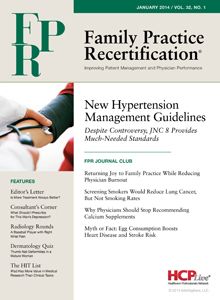Is More Treatment Always Better?
Although the aphorism "more is better" is outwardly intuitive, its application to clinical practice is best exercised with extreme caution.

Martin Quan, MD
Editor-in-Chief
The aphorism “more is better” was most recently popularized by the “It’s Not Complicated” advertising campaign of a well-known, multinational telecommunications behemoth. Although the statement is outwardly intuitive, its application to clinical practice is best exercised with extreme caution. This is evident in the number of times in the past decade that “new” treatment guidelines embodying this line of thinking have had to be retreated from following further study.
The menopause hormone therapy saga is a good example of this. For many years, estrogen therapy was primarily used to treat the vasomotor symptoms of menopause. When epidemiologic studies overwhelmingly demonstrated that hormone therapy reduced risk of coronary heart disease (CHD) in menopausal women, enthusiasm grew not only for the treatment’s expanded role in the primary prevention of CHD in those women, but also in its secondary prevention.
However, this trend was subsequently reversed after the Women’s Health Initiative (WHI), Heart and Estrogen Replacement Study (HERS), and Estrogen Replacement and Atherosclerosis (ERA) trials unexpectedly found no benefit for hormone therapy in the secondary prevention of CHD and called the treatment’s role in the primary prevention of CHD into serious question. For all intents and purposes, the findings relegated estrogen therapy back to women with recalcitrant menopausal symptoms.
Similar ebb and flow patterns have been observed in treatment guidelines for patients with diabetes and hypertension. Intensive glycemic control came into vogue after studies demonstrated reduced microvascular and neuropathic complications and possible reduced cardiovascular risk in diabetics who achieved lower glycated hemoglobin levels. But the pursuit of near-normal glucose levels has since been greatly tempered by the Action to Control Cardiovascular Risk in Diabetes (ACCORD) trial, which discovered that the use of intensive therapy to target normal glycated hemoglobin levels actually increased mortality and did not significantly reduce major cardiovascular events.
Although hypertension control has clearly been shown to benefit patients, the ideal target for lowered blood pressure remains in a state of flux. Though the Seventh Report of the Joint National Committee on Prevention, Detection, Evaluation, and Treatment of High Blood Pressure (JNC 7) generally recommends a target blood pressure of <140/90 mm Hg in all patients and <130/80 in patients with diabetes or chronic kidney disease, the recently released JNC 8 retreated in this regard by raising the target blood pressure to <150/90 for patients over 60 years old and <140/90 for patients with diabetes or chronic kidney disease.
Flowing in the opposite direction are the new American College of Cardiology (ACC)/American Heart Association (AHA) guidelines for cholesterol management. With growing evidence supporting the important role of statin therapy in both the secondary and primary preventions of cardiovascular disease, the new guidelines favor higher dosages of statins, as well as their expanded role. In addition to calling for statin use in patients with known atherosclerotic disease and those over 21 years of age with low-density lipoprotein (LDL) cholesterol ≥190 mg/dl, the new guidelines also recommend the drug’s use in patients aged 40-75 years old with LDL 70-189 mg/dl and either diabetes or a 10-year atherosclerotic cardiovascular risk ≥7.5%.
It has been estimated that adherence to the ACC/AHA guidelines will likely result in 45 million middle-aged Americans without known cardiovascular disease being recommended for statin therapy. Suffice it to say the new guidelines have already generated a fair amount of debate and controversy.
Is more really better? German philosopher Schopenhauer once said, “Opinion is like a pendulum and obeys the same law. If it goes past the centre of gravity on one side, it must go a like distance on the other; and it is only after a certain time that it finds its true point at which it can remain at rest.” Only time will tell where the pendulum for statin therapy will settle.
Martin Quan, MD
Editor-in-Chief
Martin Quan, MD, is Professor of Clinical Family Medicine and Director of the Office of Continuing Medical Education at the David Geffen School of Medicine at UCLA. He is also a member of the Education Advisory Board and consultant to the Committee on Continued Professional Development of the California Academy of Family Physicians and a member of the Kidney Learning System Advisory Board of the National Kidney Foundation. In the past, Quan has served as Program Director of the UCLA Family Practice Residency Program, Co-Director of the UCLA Pre-Doctoral Program in Family Practice, Editor-in-Chief of Clinical Cornerstone, and Vice Chair of the Residency Review Committee in Family Practice for the Accreditation Council for Graduate Medical Education (ACGME).
